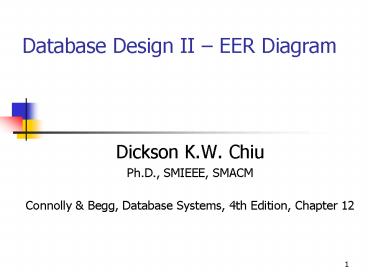Dickson K'W' Chiu - PowerPoint PPT Presentation
1 / 23
Title:
Dickson K'W' Chiu
Description:
Specialization/Generalization of Staff Entity into Subclasses Representing Job Roles ... There are four categories of constraints of specialization and generalization: ... – PowerPoint PPT presentation
Number of Views:33
Avg rating:3.0/5.0
Title: Dickson K'W' Chiu
1
Database Design II EER Diagram
- Dickson K.W. Chiu
- Ph.D., SMIEEE, SMACM
- Connolly Begg, Database Systems, 4th Edition,
Chapter 12
2
Objectives (Chapter 12)
- Limitations of basic concepts of the ER model and
requirements to represent more complex
applications using additional data modeling
concepts. - Most useful additional data modeling concepts of
Enhanced ER (EER) model called - specialization/generalization
- aggregation
- composition.
- A diagrammatic technique for displaying
specialization/generalization, aggregation, and
composition in an EER diagram using UML.
3
Enhanced Entity-Relationship Model
- Since 1980s there has been an increase in
emergence of new database applications with more
demanding requirements. - Basic concepts of ER modeling are not sufficient
to represent requirements of newer, more complex
applications. - Response is development of additional semantic
modeling concepts. (cf. object-oriented
programming) - Semantic concepts are incorporated into the
original ER model and called the Enhanced
Entity-Relationship (EER) model. - Examples of additional concepts of EER model are
- specialization / generalization
- aggregation
- composition.
4
Specialization / Generalization
- Inheritance in object-oriented programming
- Superclass - An entity type that includes one or
more distinct subgroupings of its occurrences. - Subclass - A distinct subgrouping of occurrences
of an entity type. - Superclass may contain overlapping or distinct
subclasses. - Not all members of a superclass need be a member
of a subclass. - Attribute Inheritance - An entity in a subclass
represents same real world object as in
superclass, and may possess subclass-specific
attributes, as well as those associated with the
superclass.
5
Specialization / Generalization
- Specialization
- Process of maximizing differences between members
of an entity by identifying their distinguishing
characteristics. - Generalization
- Process of minimizing differences between
entities by identifying their common
characteristics.
6
AllStaff Relation Holding Details of all Staff
7
Specialization/Generalization of Staff Entity
into Subclasses Representing Job Roles
8
Specialization/Generalization of Staff Entity
into Job Roles and Contracts of Employment
9
EER Diagram with Shared Subclass and Subclass
with its own Subclass
10
Constraints on Specialization / Generalization
- Two constraints that may apply to a
specialization/generalization - participation constraints,
- disjoint constraints.
- Participation constraint
- Determines whether every member in superclass
must participate as a member of a subclass. - May be mandatory or optional.
- Disjoint constraint
- Describes relationship between members of the
subclasses and indicates whether member of a
superclass can be a member of one, or more than
one, subclass. - May be disjoint or nondisjoint.
11
Constraints on Specialization / Generalization
- There are four categories of constraints of
specialization and generalization - mandatory and disjoint
- optional and disjoint
- mandatory and nondisjoint
- optional and nondisjoint.
12
DreamHome Worked Example - Staff Superclass with
Supervisor and Manager Subclasses
13
DreamHome Worked Example - Owner Superclass with
PrivateOwner and BusinessOwner Subclasses
14
DreamHome Worked Example - Person Superclass with
Staff, PrivateOwner, and Client Subclasses
15
Another Example
Fig. 3-48, UML Notation Guide
16
Aggregation
- Represents a has-a or is-part-of relationship
between entity types, where one represents the
whole and the other the part.
17
Composition
- Specific form of aggregation that represents an
association between entities, where there is a
strong ownership and coincidental lifetime
between the whole and the part.
18
Aggregation/Composition (contd)
- sometimes it is not clear whether the parts
should be related with or
Car
- Which aggregation association to use is a matter
of how one interprets reality and/or the
requirements of the application
19
When to use Aggregation/Composition ?
- Would you use the phrase part of to describe
the association or name it Has? - Are operations on the whole automatically applied
to the part(s) ? composition? - Are some attribute values propagated from the
whole to all or some of the parts? - Is there an intrinsic asymmetry to the
association where one object class is subordinate
to the other(s)?
- It is not wrong to use association rather than
aggregation! - Note aggregation / composition also has
multiplicity
20
EER Diagram of Branch View of DreamHome with
Specialization/Generalization
21
Another Example
22
A Model for the Korean Language
23
Chens ER-diagram Notation
Notation
Symbol
Entity types
Relationship Types
Weak Entity types
Attribute
Key Attribute (underline)
Mutivalued Attribute
Derived Attribute
Composite Attribute
1
N
R
E2
Cardinality Ratio 1 N for E1 E2 in R
E1
?
E1 is a specialization of E2 (E1 isa E2)
E1
E2






























